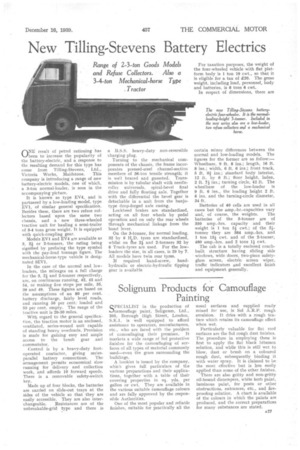New Tilling-Stevens Battery Electrics
Page 29

If you've noticed an error in this article please click here to report it so we can fix it.
ONE result of petrol rationing has 1--/been to increase the popularity of the battery-electric, and a response to the resulting demand for this type has come from Tilling-Stevens, Ltd., Victoria Works, Maidstone. This company is introducing a range of new battery-electric models, one of which, a 3-ton normal-loader, is seen in the accompanying picture.
It is known as type EV4, and is partnered by a low-loading model, type EV1, of similar general specification. Besides these, there are two refuse collectors based upon the same two chassis, and a new three-wheeled tractive unit for hauling a semi-trailer of 3-4 tons gross weight. It is equipped with quick-coupling gear.
Models EV1 and EV4 are available as 3, 211 or 2-tanners, the rating being signified by prefixing the type symbol with the pay-load tonnage figure. The mechanical-horse-type vehicle is designated 5EV1.
In the case of the normal and lowloaders, the mileages on a full charge for the 3, 2f and 2-tonner respectively, are, on continuous running, 42. 45 and 54, or making five stops per mile, 35, 39 and 49. These figures are based on the assumptions of an 80 per cent. battery discharge, fairly level roads, and running 50 per cent: loaded and 50 per cent. empty. The range of the tractive unit is 20-30 miles.
With regard to the general specification, the traction motor is an enclosed, ventilated, series-wound unit capable of standing heavy overloads. Provision is made for gaining easy and ample access to the brush gear and commutator.
Control is by a heavy-duty foot. operated contactor, giving seriesparallel battery connections. The arrangement permits economical slow running for delivery and collection work, and affords 10 forward speeds. There is a removable safety-switch key.
Made up of four blocks, the batteries are carried on slide-out trays at the sides of the vehicle so that they are easily accessible. They are also inter changeable. Resistances are of the unbreakable-grid type and there is a B.S.S. heavy-duty non-reversible charging plug.
Turning to the mechanical components of the chassis, the frame incorporates pressed-steel channel-section members of 36-ton tensile strength; it is well braced and gusseted. Transmission is by tubular shaft with needleroller universals, spiral-bevel final drive and fully floating axle. Together with the differential the bevel gear is detachable in a unit from the banjotype drop-forged axle casing.
Lockheed brakes are standardized, acting on all four wheels by pedal operation and on only the rear wheels through mechanical linkage from the hand lever.
On the 3-tonner, for normal loading, 32 by 6 HeD. tyres are standardized, whilst on fhe 2f and 2-tonners 32 by 6 Truck-tyres are used. For the lowloaders the size, in all cases, is 29 by 7. All models have twin rear tyres.
If required hand-screw, handhydraulic or electric-hydraulic tipping gear is available For taxation purposes, the weight of the four-wheeled vehicle with flat platform body is 1 ton 19 cwt., so that it is eligible for a tax of £20. The gross weight, including load, personnel, body and batteries, is 6 tons 6 cwt.
In respect of dimensions, there are certain minor differences between the normal and low-loading models. The figures for the former are as follow:— Wheelbase, 9 ft. 8 ins.; length, 16 ft.
8 ins.; width, 6 ft. 6 ins.; front track, 5 ft. 01 ins.; standard body interior, 12 ft. by 6 ft.; floor height, laden, 2 ft. 7f ins.; turning circle, 42 ft. The wheelbase of the low-loader is 9 ft. 6 ins., the loading height 2 ft.
6 ins, and the turning-circle diameter, 34 ft.
Batteries of 40 cells are used in all cases but the amp.-hr.-capacities vary and, of course, the weights. The batteries of the 3-tanner are of 350 amp.-hrs, capacity and their weight is 1 ton 51 cwt.; of the 2itanner they are 384 amp.-hrs. and 1 ton 13f cwt. and of the 2-tanner, 480 amp.-hrs. and 2 tons If cwt.
The cab is a totally enclosed coachbuilt structure having sliding side windows, wide doors, two-piece safetyglass screen, electric screen wiper, traffic indicators and excellent finish and equipment generally.




































































